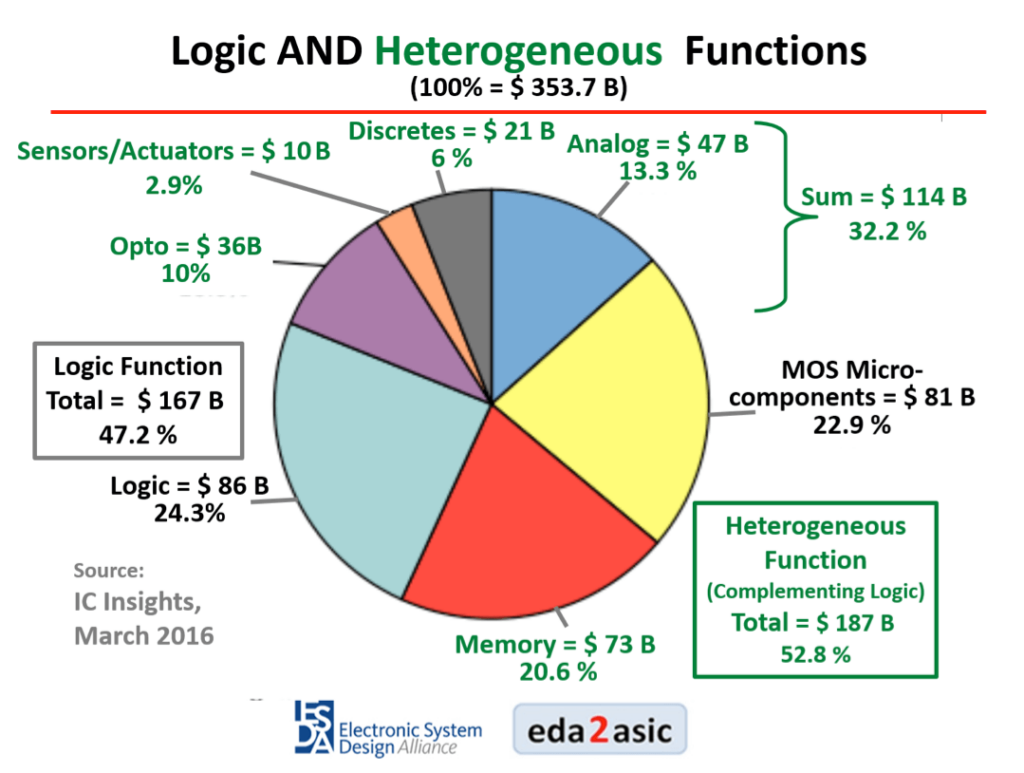My wife, born and raised in Hong Kong, tells me that the Chinese language uses the same word for challenge and opportunity. What can we, in the 200-year-old US of A, learn from the 4000 years old Chinese culture?
The Chinese have a point! Based on my personal experience, I have to say that every challenge I faced so far, opened a door to a new opportunity, making my life better and more interesting. I got a broader perspective of the world around me and met smart people. Also, the money was all right. Most of these new opportunities required me to change my normal way of doing things more or less significantly and forced me to learn new things.
What’s the bottom line here? Why am I suggesting change and learn new things? Let’s look at a few major signs of existing or emerging semiconductor industry challenges:
- The largest semiconductor vendor, Intel, is going to cut 12,000 people in the near future to refocus.
- Last week, Apple announced a decline in quarterly revenues after 13 years of continued growth.
- The semiconductor growth engine, the smartphone, shows flat to declining y/y revenues.
- 2015 brought us more than $ 100 billion of semiconductor mergers & acquisitions, four times as much as typical years.
- 2015 versus 2014 semiconductor revenues were essentially flat and, according to IC Insights, heterogeneous functions’ revenues overtook logic revenues in 2015. See the slide below from IC Insignts:

The list of challenges could go on, but I hope I got your attention to highlight now a few key opportunities:
- Automotive companies are heading toward self-driving cars and need lots of electronic systems with heterogeneous functions to get there.
- Internet of Things edge nodes, containing low-power compute engines and heterogeneous functions, will make electronic systems much smarter and, most important, “environmentally aware.”
- The rapid increase in network traffic needs solutions for fast, secure, flexible and low-power data transfers, utilizing analog and RF functions as well as electrical-optical translations.
What do all these opportunities have in common? They require us to evolve from following Moore’s Law and learn more about the possibilities and benefits More-than-Moore technologies offer. Instead of traditional PC designs, dominated by logic and volatile RAM, we’ll also need to integrate non-volatile memory as well as additional functions like MEMS, image sensors, A/D converters and electrical-optical translators to enable these systems to become our eyes, ears, noses and fingertips to watch the world around us. — Let’s not include our brains here. At least not yet…..
By the way: Multi-die ICs do not only simplify integration of heterogeneous functions into a very small form factor, they also allow you to reduce the power dissipation of these functions – compared to individual ICs on a PCB – by a factor of 3 to 10 !!!
How can you quickly, efficiently and effective add More-than-Moore knowledge to your vast More-Moore experience?
If I may suggest: Utilize some of the many educational and networking opportunities our industry offers:
#1: Please join the ESD Alliance’s charter meeting for my System Scaling Working Group in San Jose on Tuesday, May 17, at 6 pm, to voice your requirements and impact our priorities. We’ll address, in regular meetings, the power of new solutions and offer you the in-depth knowledge of More-than-Moore experts to accelerate your transition. We will review focus and priorities for this working group frequently to adapt to market changes and technology innovations.
Several other educational conferences with multi-die related content will be held before the summer break, such as:
- The MEPTEC MEMS Symposium in San Jose May 11. I look forward to meeting you there.
- As stated above, please contribute your ideas to the Electronic System Design Alliance’s plans and priorities. I’ll manage the System Scaling Working Group within this organization (formerly known as EDAC) and ask you to join our charter meeting May 17, 6pm in San Jose. As I said before: I really need you to come and impact our priorities.
- Attend the IITC AMC conference in San Jose from May 23 to 26 to hear about the latest interconnect technologies and about advanced materials, essential to continue our drive to higher level of IC integration. See you at the 3D session.
- DAC 2016, to be held in Austin, Texas, from June 5 to 9, will cover a wide range of IC design topics, address IP topics and talk about the important semiconductor application areas mentioned above. See you at the Electronic System Design Alliance’s Booth #1920.
- Last, but certainly not least, SEMICON West 2016, in San Francisco from July 12 to 14, will address many semiconductor manufacturing topics. This year’s tagline, “Definitely NOT business as usual,” clearly emphasizes the need for change.
Looking forward to working with you on transforming today’s challenges into tomorrow’s opportunities…..Herb
PS: If you didn’t make it to this year’s EDPS, in Monterey, you can read about my presentation here on EDA Cafe.


















